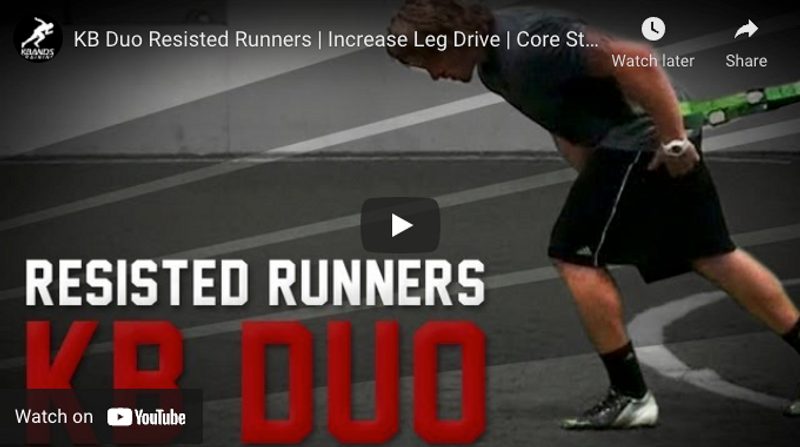KB Duo Resisted Runners
The KB Duo resisted runner is part of a set of targeted football drills designed to help athletes drive forward into a full sprint from a standstill position. This is a useful drill for linemen, running backs, and all positions that involve exploding forward off the line (and the applications of this drill extend into many other sports in addition to just football).
With the help of the KB Duo resistance training equipment, the KB Duo resisted runners help football players build strength and power in the hip flexors. They also work to train the muscle groups of the upper legs and core to burst into explosive action and maintain extreme tension for a distance of several yards down the field. These drills build general football speed, specifically running back speed, and they also build endurance over short stretches of high energy output.
Football Drills: Setting Up the KB Duo Resisted Runners
These drills will involve two partners, one of whom will be controlling the forward motion and will be gaining the primary benefits of the drill. The role of the other player, the supporting partner, will be discussed below. The most important aspect of set up for these football drills will involve adjusting the KB Duo so it fits properly around the midsection of the football player who will be pulling forward.
Football players and coaches should use the extension strap that will be included in every set of KB Duo equipment. The extension strap should be connected between one strap and handle combination and the other. Players should hook the extension strap to the carabineers on each side, resulting in a long stretch of smooth band that will lie across the midsection of the forward runner. No metal pieces should be against the football player’s clothes or skin, since the forward player will be leaning his entire weight into the straps and pulling with all his strength.
Meanwhile, once the extension strap is laid across the midsection of the forward runner, the resistance runner, or anchor, will hold the handles of both straps, one in each hand, and stand behind the forward runner as he takes his position at the starting line.
Football Drills: Body Position for the KB Duo Resisted Runners
At the starting line, the football player in the forward position will lean down so his head is pointing in the direction of motion and his center of gravity is low. The football player acting as the anchor will lean slightly back so his feet are ahead of his center of gravity and his weight is supported by the KB Duo straps looped around his partner. At the starting signal, the first player will run forward, engaging powerful leg drive and leaning at the waist with his nose toward the destination. Both partners should lean in opposite directions and trust the strap and the weight of the opposite partner to hold them up.
Football Drills: Executing the Drill
As the starting signal is given and the sprinting player takes off toward the finish line, body position for both partners will be critical to the success of the drill. Here are a few key elements to remember:
1. Keep Chest and Nose Down
2. Stay Low through the Dig Phase
3. Drive with the Hip Flexors
4. Keep the Head Low
Sprinters need to keep the chest, head, and nose in a lowered position in order to concentrate the pressure of the move in the hip flexors. This lowered, leaning position should rely on the weight of the anchor partner and should stay consistent throughout the dig phase of the sprint. If this lean is happening as it should, the sprinting partner should feel the tension in his hips and core.
Arm and leg position are very important to this move as well. Both the knees and the elbows should play a key role, and coaches observing players should comment on knee and arm position and give pointers as necessary. Here’s a quick list of guidelines:
1. Focus on High Knees and Engaged Arms
2. Drive the Knees Toward the Chest at Each Stride
3. Keep Arms Bent (The hands should swing as high as the level of the face.)
4. Be Explosive
Remember: Lazy arms contribute to lazy legs, and lower energy and drive from the legs means reduced energy output from the core, which can diminish the value of the drill.
Of course, the resistance supplied by the anchor partner will also increase the tension placed on the sprinter’s hip flexors, so anchor partners should work create the highest possible level of drag without risking loss of balance.
KB Duo Resisted Runners: Reps and Sets
This complete set of KB Duo resisted runner football drills will consist of stacked reps and sets. This means that as the length of each sprint goes up, the number of reps will drop, so as the sprinter expends his energy and approaches a state of fatigue, the reps get shorter and he can continue to give 100 percent and be totally explosive with the dig phase and the leg drive elements of the run. Here’s a quick breakdown the sets and reps for this football drill:
10 yards: 6 reps
15 yards: 4 reps
20 yards: 2 reps
Pairs can run each of these rounds of sets and reps with short breaks in between each rep and slightly longer breaks between each set. After the entire cycle, the two partners can switch positions and run the drill again. During each round of the drill, the anchor partner can observe and offer perspective on the sprinter’s form. Meanwhile, coaches should make sure both players are applying full pressure in their respective directions of motion. Pairing players of equal size and leg strength can help with this.

